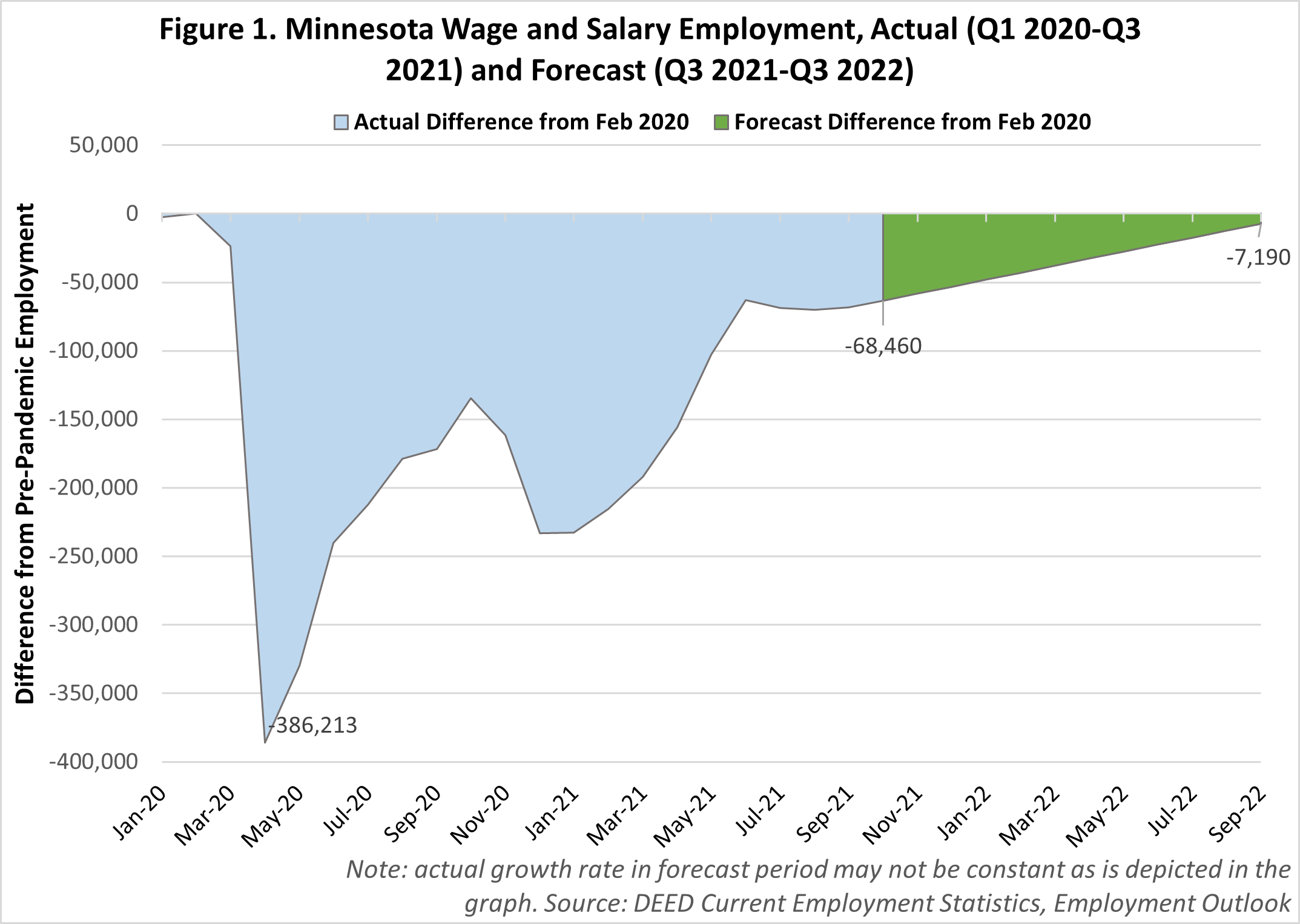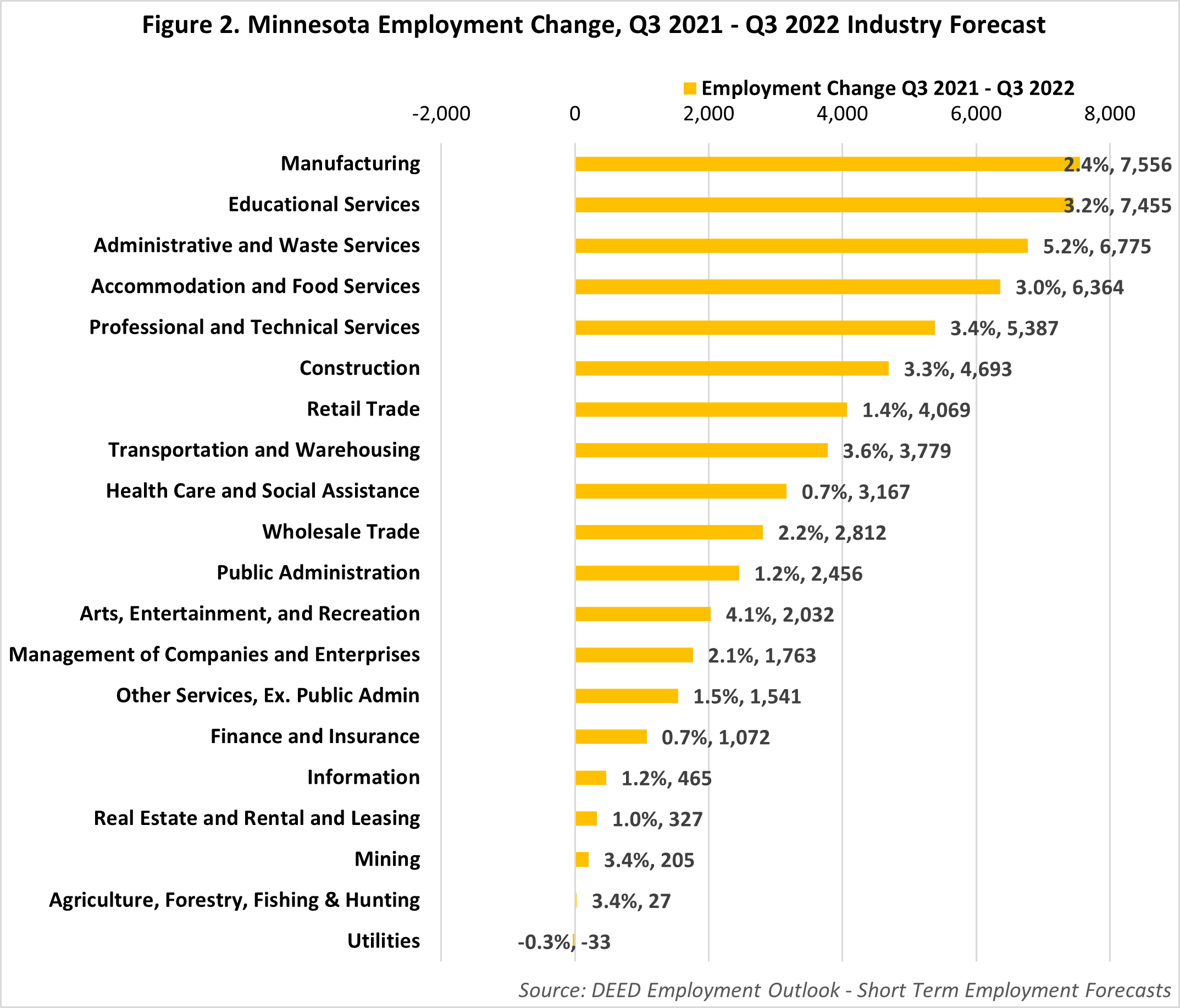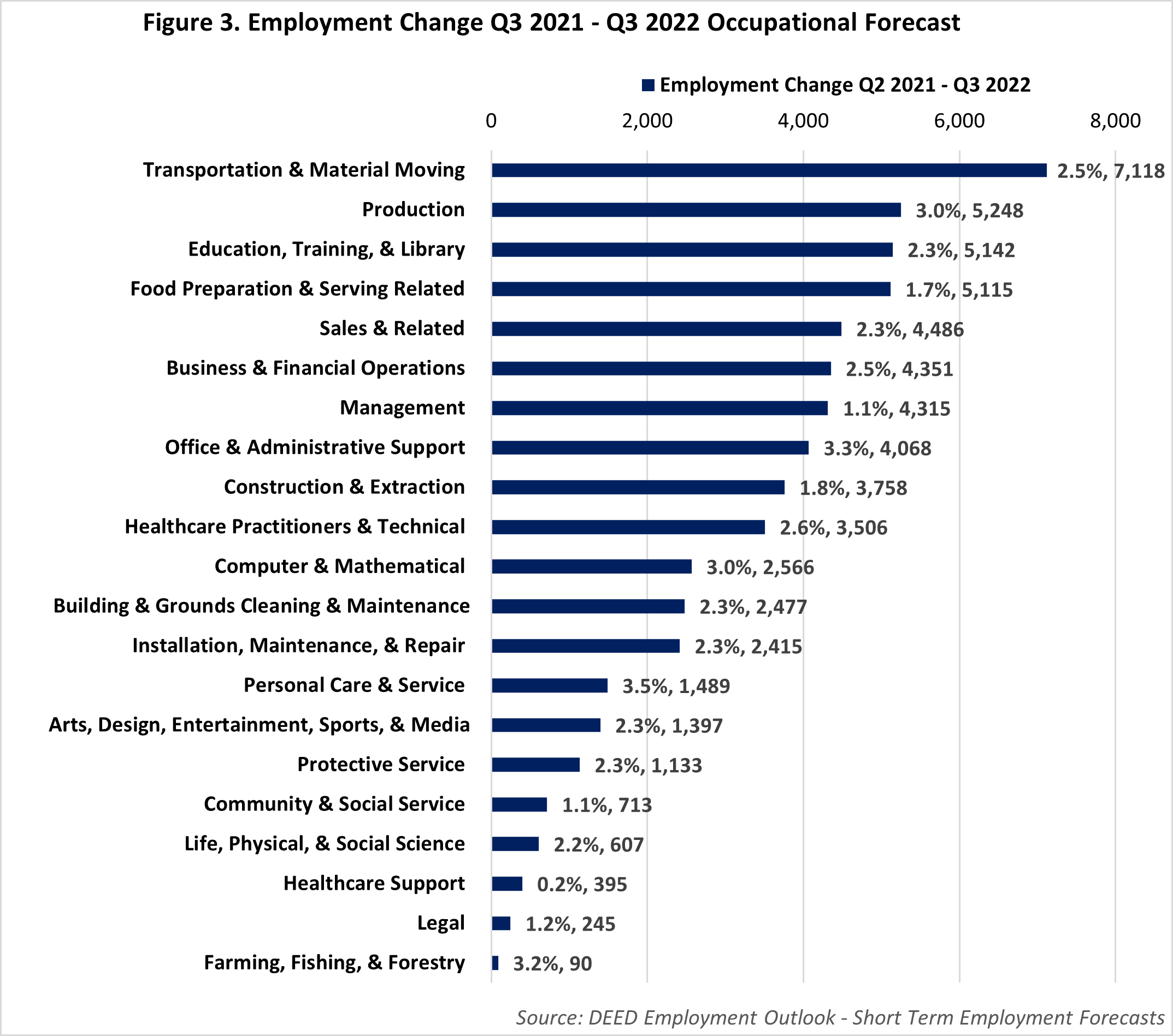
by Carson Gorecki
December 2021
According to analysis from DEED's Labor Market Information office, the state of Minnesota is projected to add just under 62,000 jobs between the third quarter of 2021 and the third quarter of 2022, an expansion of 2.1% over the year. This rate of employment growth is forecasted to slow from the more robust recovery that characterized mid-2020 to mid-2021, but still continues the state's march back to economic recovery.
One-year employment projections forecast an average of 5,159 added jobs per month which will bring employment to 99.8% of the February 2020 pre-pandemic level (see Figure 1) by third quarter 2022. Based on forecasted growth rates, statewide employment should surpass pre-pandemic levels soon after, likely in the fourth quarter of 2022 or perhaps the first quarter of 2023.

The year of employment growth from Q3 2021 to 2022 is estimated to be less robust than that which occurred in the summer of 2020 and spring of 2021, as many industries focused on recovery. Estimated near-term growth more closely matches the less dramatic 1.1% increase that marked employment change from May through September 2021. The more recent slowdown in the jobs recovery is attributable to many interrelated factors including but not limited to continued uncertainty caused by the pandemic, changing work and family preferences, and a tightening labor market. While employment grew 6% from the beginning of 2021 through the third quarter, the state's labor force expanded only 1.6%1.
Reflecting continued high demand for workers, Minnesota businesses posted record numbers of job openings in the 2nd quarter. There were almost two open jobs for every unemployed job seeker this spring – with just over 205,000 vacancies compared to less than 124,000 unemployed workers. Compounding the tight labor market, the Bureau of Labor Statistics predicts a long-term decline of labor force participation over the next decade as the workforce continues to age.
More near-term analysis by IHS Markit indicates a partial recovery of the labor force participation rate, but not enough to regain pre-pandemic labor force levels. As a result, participation will continue to be a constraint on employment growth even if there is a near term rebound under an easing pandemic. With the tight labor market, Minnesota's projected growth rate is below the national projected growth rate of 3.5% over the same period. Reasons for Minnesota's growth rate being behind the national growth rate include the labor force constraints noted above as well as the fact that Minnesota did not see as large of an initial employment loss as the nation, so we had slightly less ground to make up which would also lead to a lower projected growth rate if trends were to continue.
Despite the labor market constraints, all but one industry (Utilities) in Minnesota is expected to add jobs over the next year (see Figure 2). The largest number of jobs are expected to be added in Manufacturing, Educational Services, Administrative Support & Waste Management Services, and Accommodation & Food Services. Combined, these sectors account for over 45% of the projected job growth. Much of growth in Administrative Support & Waste Management Services, which has the fastest projected growth rate of all sectors, can be attributed to the return of demand for employment services and temporary staffing agencies, which fell by more than a quarter early in the pandemic.

Of the three largest industries in the state – Health Care & Social Assistance, Manufacturing, and Retail Trade – only Manufacturing is expected to experience above-average employment growth over the year. As a result, Manufacturing is projected to achieve employment levels near 2018 and 2019 averages. Of the 19 nonfarm sectors, Transportation & Warehousing, Wholesale Trade, Construction, Mining & Logging, and Professional & Technical Services are projected to surpass third quarter 2019 employment levels by the third quarter of 2022.
Many of the industries that saw the largest initial employment decline at the beginning of the pandemic will continue to recover, although the pace and extent of each industry's rebound is expected to vary. Arts, Entertainment, & Recreation, which has finally regained all of the 26,000 jobs lost in the second quarter of 2020, is projected to add another 2,000 by third quarter 2022. Accommodation & Food Services, which lost over 100,000 jobs in 2020, is expected to regain about a third of the remaining 19,400 job deficit.
Likewise, Health Care & Social Assistance still had a sizeable employment deficit (-16,700) as of third quarter 2021 that will be only slightly mitigated by a forecast annual growth of 3,200 jobs. Demand has returned, as evidenced by the fact that Health Care & Social Assistance and Accommodation & Food Services accounted for nearly two out of every five job vacancies in the second quarter of 2021; however, both sectors are struggling to find workers. Under almost two years of unprecedented stress, the Health Care & Social Assistance industry is more often dealing with a workforce looking elsewhere for job opportunities. Forecasted Health Care & Social Assistance growth below the all-sector average reflects this increased uncertainty.
In response to the industry trends seen above, each major occupational group is expected to add jobs over the next year. Due to skyrocketing demand, the Transportation & Material Moving occupational group is projected to add the largest number of jobs over the next year (see Figure 3). The most common occupations within the Transportation & Material Moving group are Heavy & Tractor Trailer Truck Drivers and Light Truck & Delivery Drivers, Laborers & Freight, Stock & Material Movers, and Stockers & Order Fillers.

Production jobs are expected to see the second-largest addition of jobs, working to keep up with consumer demand despite supply-chain disruptions. This includes Metal & Plastics Workers, Assemblers & Fabricators, and Food Processing Workers. Beyond that, the fastest rates of employment growth across other occupations are projected for Arts, Design, Entertainment, Sport, & Media; Construction & Extraction, and Farming, Fishing, & Forestry, all of which work in industries that saw strong growth this year.
With over 11% of employment, the largest occupational group in the state is still Office & Administrative Support. However, this group is projected to have the second-lowest rate of growth (1.1%) over the year, with signs pointing to many long-term changes in the way we work that make physical office support occupations less likely to grow. As many businesses sent workers home and remote work increased, many of the jobs that were more difficult to perform remotely such as File Clerks, Tellers, and Secretaries, became less in-demand. While these jobs will not disappear overnight, many are likely to see gradual evolutions. A sizeable decline in the construction and rental of physical office square footage hints that in the longer-term there will likely be fewer hires in in-office operations roles.
Due to the workforce constraints detailed above, Healthcare Support is projected to add fewer than 400 jobs over the year, despite having more than 158,000 filled jobs and more than 17,000 vacancies in 2021. Home Health & Personal Care Aides and Nursing Assistants alone make up over 82% of these jobs and neither is expected to grow significantly over the next year. Hospitals and particularly residential care facilities, where many of these lower-paying occupations are common, have been under enormous stress as a result of the pandemic. While demand remains extremely high, job seeker interest has not kept pace, limiting near-term growth potential.
Much of the short-term employment growth projected for the next year can still be attributed to the continued recovery from historic employment losses. Several industries and occupations have yet to regain pre-pandemic employment levels and it appears that we are still in a period of correction. For workers that were hit especially hard at the onset of the pandemic, such as those in Leisure & Hospitality and Other Services, large projected growth rates will not quite bring those occupations back to early 2020 employment levels. The context of what happened to a specific occupation or industry between March 2020 and the third quarter of 2021 is crucial to understanding the trajectory that growth may take over the next year.
The COVID-19 pandemic continues to inject uncertainty into the labor market in Minnesota. The future of Minnesota's employment remains difficult to predict among many quickly changing variables. What we do know is that the unpredictable nature of the virus will continue to impact the behavior of businesses, workers, and job seekers alike. These are trends that continue changing how, where, and when we work, both now and for the foreseeable future and are playing out against larger, long-standing demographic trends that limit the size of available labor force and in turn constrain job growth. Despite this uncertainty, the jobs recovery is expected to continue in Minnesota into 2022.
1DEED Local Area Unemployment Statistics